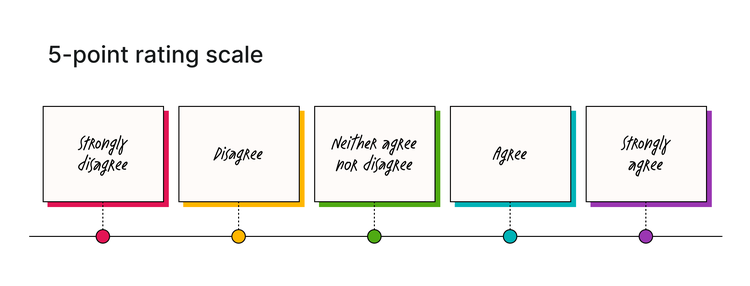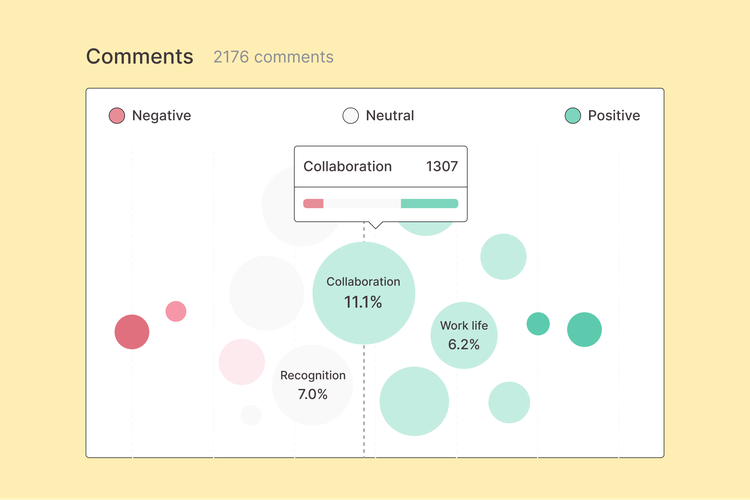
The benefits of using open-ended survey questions in surveys

Conducting regular employee surveys allows your business to collect open and honest feedback from employees, as well as track changes in employee sentiment over time. To determine the latter, most organizations use closed questions – questions that ask employees to pick from a limited set of answers – in their surveys. This question type allows your business to quantify topics like employee engagement, manager satisfaction, candidate experience, and more.
While it’s important to know what is happening in your organization, it’s just as important to know the why behind these occurrences. Closed questions can help you identify your symptoms, but they often fail to find the root cause of an issue. Luckily, that’s where open-ended questions shine. These types of questions allow employees to flesh out their responses, so you can get to the bottom of the trends revealed by your quantitative data.
In this article, we explore the difference between open- and close-ended questions, the pros and cons of asking open-ended questions, and example questions you can include in your own workplace surveys.
Open-ended vs. close-ended questions
Before we dive into the benefits of asking open-ended questions in engagement surveys, let’s take a closer look at what open-ended questions are and how they differ from closed questions.
Close-ended questions
This type of question asks respondents to pick a response from a set of predetermined answers. Most businesses use the Likert question format, which presents a statement and then asks employees to choose from a scale of response options representing different levels of agreement with that statement (e.g. Strongly Disagree, Disagree, Neither Agree nor Disagree, Agree, and Strongly Agree).

Since closed questions have a consistent answer format, they are a great way to collect and analyze quantifiable data from your engagement surveys.
Example of a close-ended question:

Open-ended questions
Open-ended questions, on the other hand, collect qualitative data. These questions cannot be answered with a simple “yes” or “no;” they require employees to write their own response to the prompt. Open-ended questions allow employees to expand on or add context to their close-ended question answers.
Example of an open-ended question:
How does our company recognize hard work?
Pros and cons of asking open-ended survey questions
Before you throw a few open-ended questions into your next workplace survey, consider the benefits and downsides of doing so. We’ve listed some of the most common pros and cons of including open-ended questions in surveys below.
Pros
-
Allow employees to share additional context.
Closed questions only tell you so much. For example, say a close-ended question on your engagement survey asks employees how strongly they agree with the statement, “I believe there are good career opportunities for me at this company,” and an employee selects the “Strongly Agree” response. Alone, this score paints a rosy picture of how this employee anticipates growing within their role, when in reality, the response might leave out some context the employee wants to share.
Allowing employees to add a comment to their response, or asking it as an open-ended question instead would allow this employee to share more details about why they selected that response. Given the chance to elaborate, the employee might add that while they believe there are strong growth opportunities available to them within your organization, they don’t want to pursue any promotion opportunities on their current team due to poor management and unclear priorities. This example shows how using both question types together allows your employees to add context to their responses and give your business clear, actionable insights into your workplace and employee experience. -
Give your business qualitative data.
Your business can and should collect data beyond employee net promoter score (eNPS). In fact, free response questions can offer more actionable insights for your business as they give you a deeper understanding of the day-to-day employee experience at your organization. They can back up your quantitative data and help direct where your business invests in improvements. Plus, your business can use survey comments to humanize the quantitative data and tell a more compelling story with your survey findings. -
Give you a better idea of employee sentiment and opinions.
While questions using the Likert scale are straightforward, they fail to give your business insight into employees’ emotions. Offering employees an outlet to share their thoughts – the good and the bad – via open-ended questions or survey comments can help your business better understand how passionately employees feel about different aspects of life at your company.
Cons
-
Hard to analyze or compare answers.
Engagement surveys are designed the way they are for a reason. Using close-ended questions, your business can ask everyone the same questions and easily compare the results to find trends and insights. On the other hand, open-ended questions allow for infinite answer possibilities, so your business can’t easily compare answers.
While repetition and patterns may emerge in open-ended responses, odds are that some of this employee feedback will be specific to the individual, team, or department and not applicable to the entirety of your organization. That said, it’s still valuable to collect these responses, mine them for insight into the employee experience, and learn where your business can take action to build a better workplace. -
Lower response rates
It’s easy to click a predetermined answer, but writing a thoughtful free-response answer requires more effort. Many employees complete engagement surveys as quickly as possible, without taking the time to type out additional responses. Luckily, your business can keep participation rates high by keeping open-ended questions optional, so employees don’t have to leave comments if they don’t want to.
To encourage responses to open-ended questions, make sure your employees know the purpose of your surveys and that their answers can help instigate real change within your organization. -
Time-consuming to sort through
It’s easy to consolidate, filter, and analyze quantitative engagement survey data, but the same can’t be said about qualitative data. To pull meaningful insights, you will have to manually review employee responses. If you’re looking to quickly turn around survey results, this step can hold up your progress. Still, even a few well-thought-out responses can add context and meaning to your quantitative data and guide your company’s decision-making.
30 open-ended question examples you should include in surveys
Looking to introduce some new engagement survey questions with free response sections? Check out these open-ended question examples for inspiration.
Employee job satisfaction
- What is the most interesting part of your job?
- What is the most meaningful part of your job?
- What is one thing you would change about your job?
- Is there anything preventing you from doing your job well?
- What motivates you to do your best at work?
- How do you define success within your role?
Manager satisfaction
- How does your manager recognize hard work?
- What type of feedback does your manager share with you?
- Why do you feel management does or does not take feedback seriously?
- What opportunities do you have to share feedback with your manager?
- How would you describe your manager’s communication skills?
Organization
- What are some things we’re doing really well here?
- What are some things we’re not doing so well here?
- Describe how hard work is celebrated within our organization.
- How could our organization improve performance reviews?
- How could our organization improve career development?
- What do you think of our company values?
- What do you think of our company mission?
- How would you say communication around change is handled within our company?
- How confident do you feel about where the company is going?
- How aligned do you feel with where the company is going?
- How have you seen our company work to create an inclusive workplace?
- How do you feel the organization supports your wellbeing?
Leadership satisfaction
- How confident are you in our organization’s leaders?
- How can management improve our organization?
- What would you like our leadership team to stop doing?
- What opportunities do you have to share feedback with senior leadership?
- How do you feel our leaders handle communicating change?
Other
- What’s on your mind that you would like us to know?
- Anything else to share?
Engagement surveys aren’t the only types of employee questionnaires that can benefit from open-ended questions. Check out our blog for more example survey questions and ideas on how to incorporate these questions into onboarding, stay, offboarding, employee pulse, and other surveys.
How Culture Amp collects open-ended survey questions
Collecting open-ended survey responses is simple when you have the right system in place. With a people experience platform like Culture Amp, you can easily add space for optional survey comments next to every survey question. This is a great solution as it allows you to collect both quantitative and qualitative data for each survey question. Plus, since these write-ins are optional, employee participation remains high, and everyone can say everything they want.

In our “cons” section, we mentioned that analyzing open-ended question responses can be time-consuming, but Culture Amp helps streamline this process. Culture Amp’s Text Analytics tool uses machine learning to tag each employee comment with a topic name and a sentiment (e.g. negative, neutral, or positive). Then, the platform presents aggregate data in a high-impact, interactive chart that’s available the moment your survey closes, making it easy to understand how your employees feel about key topics at a glance. From that bird’s-eye view, you can click into and view individual responses, so you don’t miss a thing.

With every survey, Culture Amp gives businesses the option to include an end-of-survey box for people to share miscellaneous feedback, giving your business access to even more employee insights. Asking the simple question “Anything else to share?” gives employees one last opportunity to say what’s on their mind and share anything that wasn’t addressed in previous questions.

Give your people a voice with Culture Amp
Learn how your business can collect quantitative and qualitative data with every engagement survey




